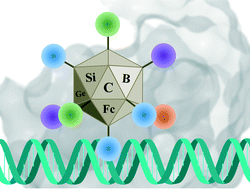Expanding the chemical space of hydrophobic pharmacophores: the role of hydrophobic substructures in the development of novel transcription modulators†
Abstract
Interactions between biologically active compounds and their targets often involve hydrophobic interactions, and hydrophobicity also influences the pharmacokinetic profile. Nevertheless, comparatively less attention has been given to the utilization of hydrophobic substructures other than hydrocarbons in the design of biologically active compounds. Herein the author reviews the development of novel transcription modulators incorporating three types of substructures, i.e., silyl and germyl functionalities, hydrophobic boron clusters, and cyclopentadiene-based organometallic sandwich compounds, as hydrophobic components.


 Please wait while we load your content...
Please wait while we load your content...